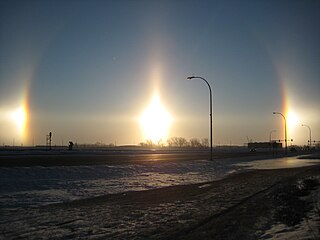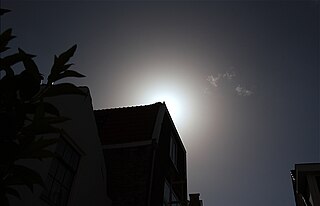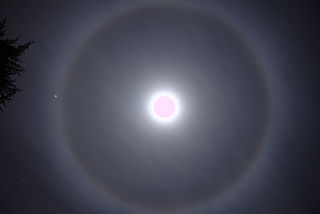
Sunrise is the moment when the upper rim of the Sun appears on the horizon in the morning, at the start of the Sun path. The term can also refer to the entire process of the solar disk crossing the horizon.

An aureola or aureole is the radiance of luminous cloud which, in paintings of sacred personages, surrounds the whole figure.

A glory is an optical phenomenon, resembling an iconic saint's halo around the shadow of the observer's head, caused by sunlight or moonlight interacting with the tiny water droplets that comprise mist or clouds. The glory consists of one or more concentric, successively dimmer rings, each of which is red on the outside and bluish towards the centre. Due to its appearance, the phenomenon is sometimes mistaken for a circular rainbow, but the latter has a much larger diameter and is caused by different physical processes.

A sun dog or mock sun, also called a parhelion in atmospheric science, is an atmospheric optical phenomenon that consists of a bright spot to one or both sides of the Sun. Two sun dogs often flank the Sun within a 22° halo.

A halo is an optical phenomenon produced by light interacting with ice crystals suspended in the atmosphere. Halos can have many forms, ranging from colored or white rings to arcs and spots in the sky. Many of these appear near the Sun or Moon, but others occur elsewhere or even in the opposite part of the sky. Among the best known halo types are the circular halo, light pillars, and sun dogs, but many others occur; some are fairly common while others are extremely rare.

Atmospheric diffraction is manifested in the following principal ways:

A coronagraph is a telescopic attachment designed to block out the direct light from a star or other bright object so that nearby objects – which otherwise would be hidden in the object's bright glare – can be resolved. Most coronagraphs are intended to view the corona of the Sun, but a new class of conceptually similar instruments are being used to find extrasolar planets and circumstellar disks around nearby stars as well as host galaxies in quasars and other similar objects with active galactic nuclei (AGN).

Heiligenschein is an optical phenomenon in which a bright spot appears around the shadow of the viewer's head in the presence of dew. In photogrammetry and remote sensing, it is more commonly known as the hotspot. It is also occasionally known as Cellini's halo after the Italian artist and writer Benvenuto Cellini (1500–1571), who described the phenomenon in his memoirs in 1562.

A Bishop's Ring is a diffuse brown or bluish halo observed around the sun. It is typically observed after large volcanic eruptions. The first recorded observation of a Bishop's Ring was by Rev. Sereno Edwards Bishop of Honolulu, after the Krakatoa eruption of August 27, 1883.

The antisolar point is the abstract point on the celestial sphere directly opposite the Sun from an observer's perspective. This means that the antisolar point lies above the horizon when the Sun is below it, and vice versa. On a sunny day, the antisolar point can be easily found; it is located within the shadow of the observer's head. Like the zenith and nadir, the antisolar point is not fixed in three-dimensional space, but is defined relative to the observer. Each observer has an antisolar point that moves as the observer changes position.

A rainbow is an optical phenomenon caused by refraction, internal reflection and dispersion of light in water droplets resulting in a continuous spectrum of light appearing in the sky. The rainbow takes the form of a multicoloured circular arc. Rainbows caused by sunlight always appear in the section of sky directly opposite the Sun. Rainbows can be caused by many forms of airborne water. These include not only rain, but also mist, spray, and airborne dew.

The Belt of Venus – also called Venus's Girdle, the antitwilight arch, or antitwilight – is an atmospheric phenomenon visible shortly before sunrise or after sunset, during civil twilight. It is a pinkish glow that surrounds the observer, extending roughly 10–20° above the horizon. It appears opposite to the afterglow, which it also reflects.

A circumhorizontal arc is an optical phenomenon that belongs to the family of ice halos formed by the refraction of sunlight or moonlight in plate-shaped ice crystals suspended in the atmosphere, typically in actual cirrus or cirrostratus clouds. In its full form, the arc has the appearance of a large, brightly spectrum-coloured band running parallel to the horizon, located far below the Sun or Moon. The distance between the arc and the Sun or Moon is twice as far as the common 22-degree halo. Often, when the halo-forming cloud is small or patchy, only fragments of the arc are seen. As with all halos, it can be caused by the Sun as well as the Moon.

The circumzenithal arc, also called the circumzenith arc (CZA), the upside-down rainbow, and the Bravais arc, is an optical phenomenon similar in appearance to a rainbow, but belonging to the family of halos arising from refraction of sunlight through ice crystals, generally in cirrus or cirrostratus clouds, rather than from raindrops. The arc is located a considerable distance above the observed Sun and at most forms a quarter of a circle centered on the zenith. It has been called "a smile in the sky", its first impression being that of an upside-down rainbow. The CZA is one of the brightest and most colorful members of the halo family. Its colors, ranging from violet on top to red at the bottom, are purer than those of a rainbow because there is much less overlap in their formation.

A parhelic circle is a type of halo, an optical phenomenon appearing as a horizontal white line on the same altitude as the Sun, or occasionally the Moon. If complete, it stretches all around the sky, but more commonly it only appears in sections. If the halo occurs due to light from the Moon rather than the Sun, it is known as a paraselenic circle.

A 22° halo is an atmospheric optical phenomenon that consists of a halo with an apparent diameter of approximately 22° around the Sun or Moon. Around the Sun, it may also be called a sun halo. Around the Moon, it is also known as a moon ring, storm ring, or winter halo. It forms as sunlight or moonlight is refracted by millions of hexagonal ice crystals suspended in the atmosphere. Its radius, as viewed from Earth, is roughly the length of an outstretched hand at arm's length.

Cloud iridescence or irisation is a colorful optical phenomenon that occurs in a cloud and appears in the general proximity of the Sun or Moon. The colors resemble those seen in soap bubbles and oil on a water surface. It is a type of photometeor. This fairly common phenomenon is most often observed in altocumulus, cirrocumulus, lenticular, and cirrus clouds. They sometimes appear as bands parallel to the edge of the clouds. Iridescence is also seen in the much rarer polar stratospheric clouds, also called nacreous clouds.

Atmospheric optics is "the study of the optical characteristics of the atmosphere or products of atmospheric processes .... [including] temporal and spatial resolutions beyond those discernible with the naked eye". Meteorological optics is "that part of atmospheric optics concerned with the study of patterns observable with the naked eye". Nevertheless, the two terms are sometimes used interchangeably.

A Lowitz arc is an optical phenomenon that occurs in the atmosphere; specifically, it is a rare type of ice crystal halo that forms a luminous arc which extends inwards from a sun dog (parhelion) and may continue above or below the sun.

Optical phenomena are any observable events that result from the interaction of light and matter.


























